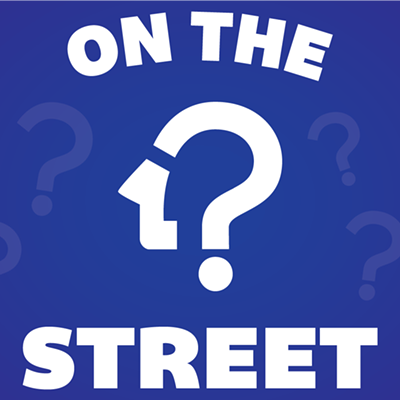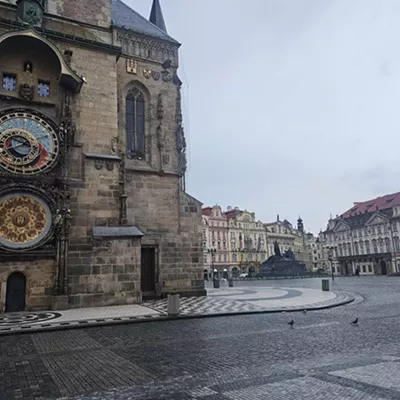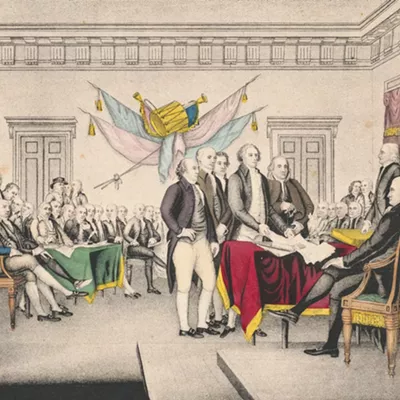As I talk to her on the phone, "Mary" sounds just like many other 20-year-olds. She's articulate, she's going to college, she volunteers in the community and she's not afraid to talk. That last part is the most remarkable thing about her, because it's not a particularly nice story she's got to tell. Mary began using meth when she was 13, and by the time she was 14 she was using both meth and heroin. She was living in the streets, sometimes sleeping in a park, but mostly returning to the place that was home to her during her two-year ordeal -- a nasty old dilapidated building were she'd squat.
"It all started when I was having a lot of problems at home. I was about 13 when I met a guy who was 17, and I tried a line [meth] with him at first," says Mary, who asks that we not use her real name. "I left home with him, and we ended up going to Seattle. Someone introduced me to shooting meth [intravenously], and I thought the feeling was so great. Then I tried heroin, and I liked that more."
Lynn Everson has heard stories like Mary's many times. Everson runs the Needle Exchange Program in downtown Spokane, and she occupies a crucial battlement in the fight against drug use in the city. She refers young people to assistance, and she believes the community doesn't fully grasp the depth of the problem. Meth use, she says, is just a symptom -- a terrible symptom -- of the cycle of abuse and disintegrating families that too many Spokane children find themselves caught in.
"If an adult leaves a violent and abusive situation in their home, we help them, we support them," says Everson. "But if a kid leaves the same situation, we blame the child. They have valid reasons to leave their homes, but they have few places to go. Some end up being sheltered by pedophiles. That's what we sentence them to, because we don't help them."
After her first tastes of meth and
heroin, Mary found herself using heroin every day, and meth between six and 10 times a week.
"I was pretty strung out, I was high as a kite, it was bad," she says.
Mary isn't alone. The latest surveys show 11 percent of Washington's high school seniors say they have tried meth. And the Spokane Police Department is still struggling to keep up with the pace of the local meth cooks. Though the SPD estimates that most of the meth snorted, ingested and shot in Spokane is made out of town, the department busted 86 labs in the first six months of 2001 -- that's 12 more than were busted in all of 2000.
Both police officers and health officials agree that meth is by far the worst drug they've seen hit the streets because it's so addictive. Somewhere between 92 and 95 percent of first-time users become addicted, and the habit isn't cheap.
"I had a habit worth $40-50 a day," says Mary.
Unlike some meth users, however, Mary never worked as a prostitute to support her habit.
"I didn't go quite that far. But there are a million other ways I have degraded myself, mostly to get money," she says. "I actually panhandled, it was easy." In the streets of Seattle she was able to beg her way to about $70 every day.
"I was small, I looked like a little, young girl. I think that's why I made so much," she says, still surprised by her own success as a beggar. Panhandling outside the downtown bars was the best.
"I guess drunk people just give you more money. Sometimes people would give me $20 at a time," says Mary. "But I also sold some drugs."
Regardless of her drug involvement and her street life, Mary was never arrested by the police for possession or for selling drugs.
"I guess I was lucky that way," she says. "I got picked up twice, but it was because I had a runaway report filed on me both times."
Before she even knew it, Mary was hooked solid, and all her friends were, too.
"It was in '94 I started using meth, and over the course of the summer, everyone I knew was using it," she recalls.
That doesn't mean that all Mary's friends from school and the neighborhood back in Spokane had turned into drug addicts over summer. Instead, Mary started hanging out with people she knew were using drugs.
"When I ran away from home, I started being with the same group of people. It was almost like being in a gang, you know, or getting a new family," she says. "I felt like I belonged with them.
"Don't get me wrong. It's very lonely being a user," Mary continues. "While you're using, you feel like you have friends. But when the drug takes over, and you just want that next high, you'll step on your friends to get there. You don't think straight; it's not your brain that's thinking, it's the drugs that are running the show for you."
But when everyone starts to come down after the rush, things can turn really ugly.
"The meth rush is, like, the greatest feeling in the world, the rush lasts about 30 seconds after you've injected it," explains Mary. "But after a couple of hours, you start coming down and you get really edgy. Everything irritates you. Everything bothers you. You can't eat, you can't drink."
She got to a point where she couldn't even eat a bowl of minestrone soup, because the tomato-red color of the liquid reminded her of what cooked-up meth and heroin look like.
The combination of being extremely addicted and feeling as if she couldn't return to her family kept Mary in Seattle and on drugs.
"I mean, with my family, I'll say I didn't have a whole heck of a lot of support," she says. "I felt like I just couldn't come back to them."
Today, looking back, she says she doesn't even remember all of what happened in the two years she was on drugs.
"You go through it, not knowing what's happening," she says. Then she pauses. "Bad things happen. I mean really bad things, and you sweep it under the rug, you don't want to see it. You can't deal with it when you're on drugs."
There are some memories, however, that will stay with Mary forever. The worst came on her 15th birthday. She was doing drugs with her friends, just as on any other day. But that day, things didn't go as planned. Her best friend overdosed.
"It was my best friend. I mean, try to understand this. My best friend overdosed on heroin. My very, very best friend died right there, in front of me, and that was on my 15th birthday. That's when I got so scared. And for the first time I thought clearly about quitting."
But how could she get out?
In Everson's experience, an abusive home environment or parents' drug use often leads to a teen's own problems.
"About 80 percent of female addicts have been sexually abused, and that number is not much lower for men," says Everson. "The average age of entry into prostitution is 14, and 90 percent of the children who end up in prostitution have been sexually abused already." But she cautions that prostitution can't be blamed on drug use or visa versa.
"That really is a chicken-and-egg question," says Everson. "Some people are using alcohol and marijuana when they are between eight and 10. Then, once they end up in the streets, other drugs are made available to them, and they need to make more money for that, so they turn to prostitution. We blame the drug use on the addict, but imagine a life that is so hellish, the only thing you can do is to numb up? That's really where the problem begins."
Everson's collection of true stories of what the youngest and most vulnerable drug users have gone through is truly heartbreaking.
"I met a girl who got her first syringe out of her mom's dresser. Or this other girl who was kicked out of her mom's house because her mom's boyfriend made a pass at her, yet her mom was afraid to lose him because he supplied her with drugs," says Everson.
"It's just a nightmare. I don't think people understand the issues that lead up to why these kids end up using drugs," says Everson. "Some people like to say the kids have a choice to say 'no' to drugs, but I don't believe that. I mean, what is the choice they are looking at? To actually feel the anger, the abuse and the chaos at home, or to numb up by using drugs? If you are in prostitution, you can't have sex with strangers without numbing yourself up with drugs. I mean, what would we choose? We'd numb up really fast."
And there are precious few resources available for the homeless children who are most at risk.
The meth problem has become so big, so fast, that even the police agree that the only realistic way out of the problem is through treatment. There simply aren't enough jail cells or police officers to handle the problem via traditional law enforcement. Some part of the problem must be tackled by getting people to choose to quit. But so far the ability to treat users has not kept up with demand, especially for those unable to pay.
Since meth is so addictive, few users are able to kick the habit without professional help. Where inpatient treatment is available, for instance at Deaconess Medical Center or at some of the many private clinics in and around Spokane, patients usually have to pay for the treatment one way or the other. But there are few programs available for users without economic resources.
"A person who has no resources goes to the Department of Social and Health Services and asks for treatment," says Everson. "They'll be required to keep two or three appointments before they are referred. But there is limited access, and they may end up having to wait two or three months before they are referred to the actual treatment program."
In that period, things can go horribly wrong. It's one thing to decide to get out of drugs; it's quite another to achieve it -- especially if you have to wait.
"I went on one of those wilderness programs when I was 14," says Mary. "It was one of those programs where you hike all day with a big backpack and you walk and walk and they do everything to exhaust you. It was very rough; I had very heavy withdrawals. After that, I knew my system was clean, but I didn't really want to get out of using drugs."
Soon after, Mary was back in the drug habit. But then her friend died.
"I was very depressed, and I had sort of a nervous breakdown. This was in March following the wilderness program. I finally went and stayed at my dad's house," she says. She did what she could to patch things up with her family in Spokane as she kicked the drug addiction -- today she lives with her mom -- yet she didn't go back into treatment.
"I think that was kind of a stupid choice, but I hated the first treatment program and didn't want to go back," says Mary. "I don't want to make myself some kind of hero, but I was very lucky that I was able to kick the habit. The only reason I didn't go into treatment again was because I was scared."
Instead, she began working 12 hours a day for six days a week. She avoided everyone -- new as well as old friends -- and kept on working.
"I felt like I had to stay away from people. I was in this kind of limbo for a long time: I couldn't go back to my old friends because they were still using, and I didn't feel like I belonged in my family either," she says. "I was an alien."
She struggled along like that for several years.
"The first two years are really, really hard. You have to build your life up from nothing," says Mary. "And in the back of your mind, the drug use is always there."
Everson says most of the clients she sees on a regular basis want to quit the drugs they are on, but very few have the strength it takes actually to succeed.
"They talk about quitting all the time, but they feel like they can't, like they can't possibly succeed," she says. "But I always tell them they are so unbelievably strong. I mean, they get out of bed or out from underneath a bridge every morning facing horrific odds, and they try again. That's remarkable."
Mary kept trying, and she kept herself as busy as she could. She looks back at her time trying to kick her meth habit and believes it would have gone easier if she had gotten treatment.
"I really should have done that. I'll say that's the first step to really getting out: get treatment," she says. If nothing else is available, go to a meeting at Narcotics Anonymous (NA) or show up at the Needle Exchange Center.
"There are no questions asked here," says Everson. "We provide referrals to all types of health services, and NA rents the site for its meetings every Tuesday."
Today, Mary is about to complete her first two years of college, which, in her own words, has given her something to live for -- and something to lose. She plans to go on to study biology.
"If someone had told me five years ago that I was going to major in biology, I would have laughed in their face," she says. "If you read this thinking you have nothing to lose, then I'm here to tell you that you are wrong. You have to make that choice to have a life."
But it's hard to reach an addict with that message.
"When I was 13 and using, if I had read some girl saying this, I would have thought, 'What a loser. I don't want to be like that,' " says Mary. "It really hurts to look back and see that's how I was thinking. But I didn't want anything other than the drug for myself."
She says she's paid a high price for her drug experience.
"I lost my self-respect. I've lost friends. Friends have gotten diseases, and they have turned on me. That's what happens when you pull the rug out from underneath yourself."
So does she know she's going to stay clean?
"Yes," Mary answers right away. "I know I'll stay clean. I've given myself something to lose, a life that I totally love today. And that's key."














